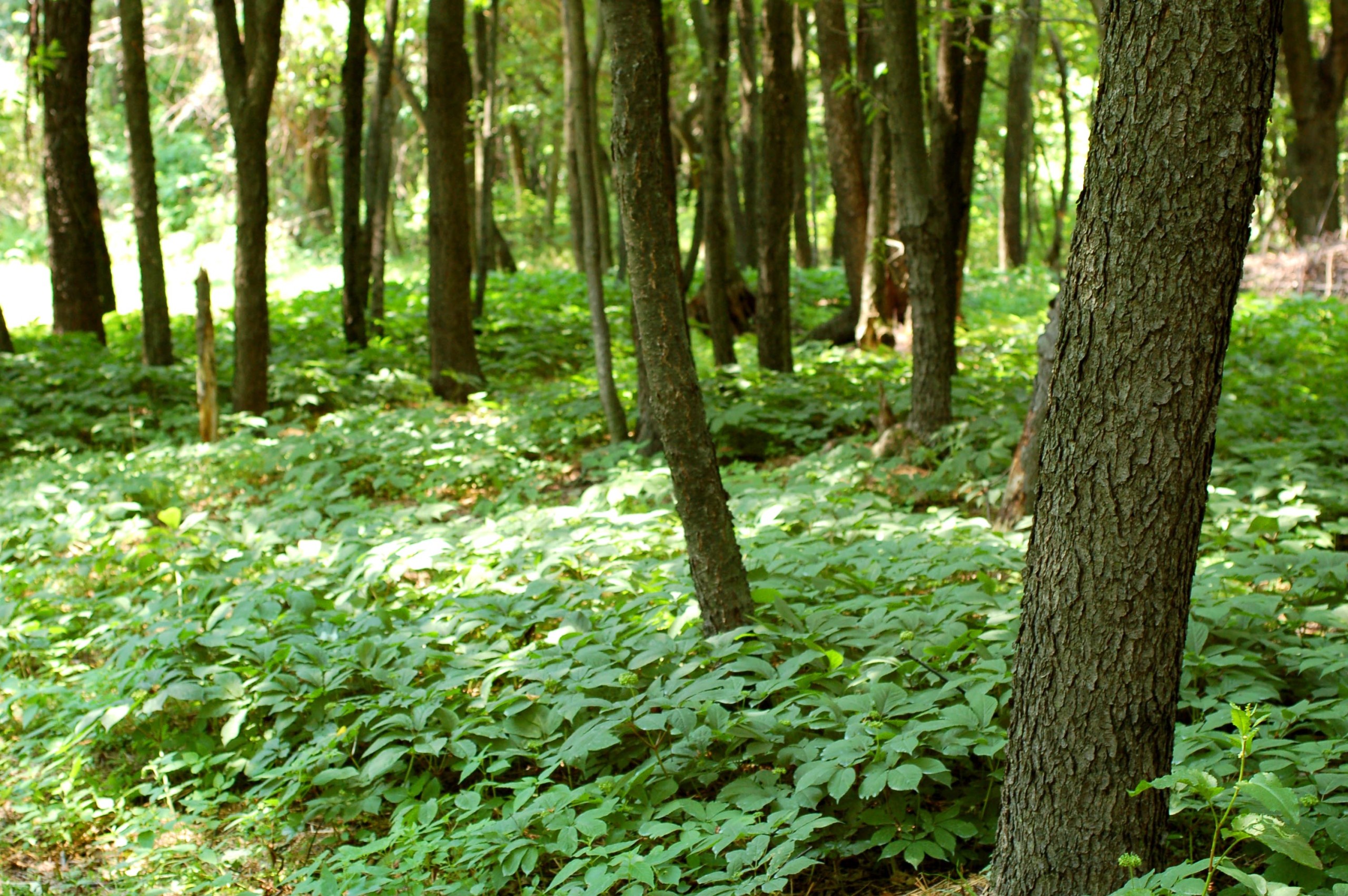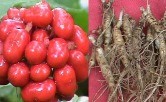PLANTING/GROWING WILD SIMULATED GINSENG
A How to Guide for Planting & Growing Wild-Simulated Ginseng
A method of planting ginseng called wild-simulated can be used to grow ginseng without too much effort, provided you don’t mind some physical labor. The prices paid for quality wild-simulated roots can and do approach that of wild roots.

Growing Ginseng can be Challenging
There are many circumstances, uncontrollable events and environmental issues, as well as pests/varmints that affects ginseng growth.
Where to plant, soil conditions, having enough good shade, how to plant and what to plant ( seed or rootlets).
The area you pick to plant may not be good for ginseng growth. Fungal diseases that attack the plant and root will certainly be a problem if it is planted too thick.
On the other hand, if the conditions are right, if you choose a good site for ginseng growth, growing wild-simulated ginseng can be very satisfying. A supplemental income, money for Christmas, help with college tuition, retirement income and more can be realized. Or maybe just some extra spending money from a hobby you enjoy. Not to mention spending many hours in the forest experiencing all it has to offer.
These are some of the issues we will discuss in an attempt to help would be growers with making the decision to grow wild simulated ginseng.
Pests and Varmints
When planting ginseng in the forest there are many pests/varmints to be concerned with.
Deer will eat ginseng plants as well as the berries that produce the seed.
Turkey will not only eat the berries, they will scratch the young root to the surface which then dries out and dies. Their scratching will also take the rhizome, aka neck, off the older root. This will cause the plant/root to not grow until it produces a new bud after a year or two, or die all together.
Then there are the mice that eat the seed and root, the chipmunk that runs off with and eats the seed. The voles and moles and any other rodent you can think of that will do some sort of damage. Slugs, bugs, and even skunks will do some damage. There is always something or some kind of pest to look for and worry about when growing ginseng.
One of the top three worse varmints if not the worse, next to deer and turkey, are the Human Thieves!!!!! And probably the hardest to stop.
Where to Plant Ginseng
It is best to plant on private land you own or can lease to have some control over and to keep quiet about what you are doing. Growing ginseng away from areas where ginseng hunters search is also a good way to keep your crop safe from poachers/ thieves.
Good growing conditions for ginseng are more difficult to find in flat land regions than in the mountains or hilly regions of the country. The forest floor in most flat land areas is too hot and dry during the summer months for ginseng to thrive. There are some small moist environments that are good, if not perfect, places to grow ginseng. Small pockets of cooler soil can be found quite often on a north to east facing hillside of a small cove type area above a stream or river. Many landowners with the right conditions are successfully growing ginseng well out of the mountains. I actually don’t mind rolling hill regions and have helped quite a few growers get started in those type of areas.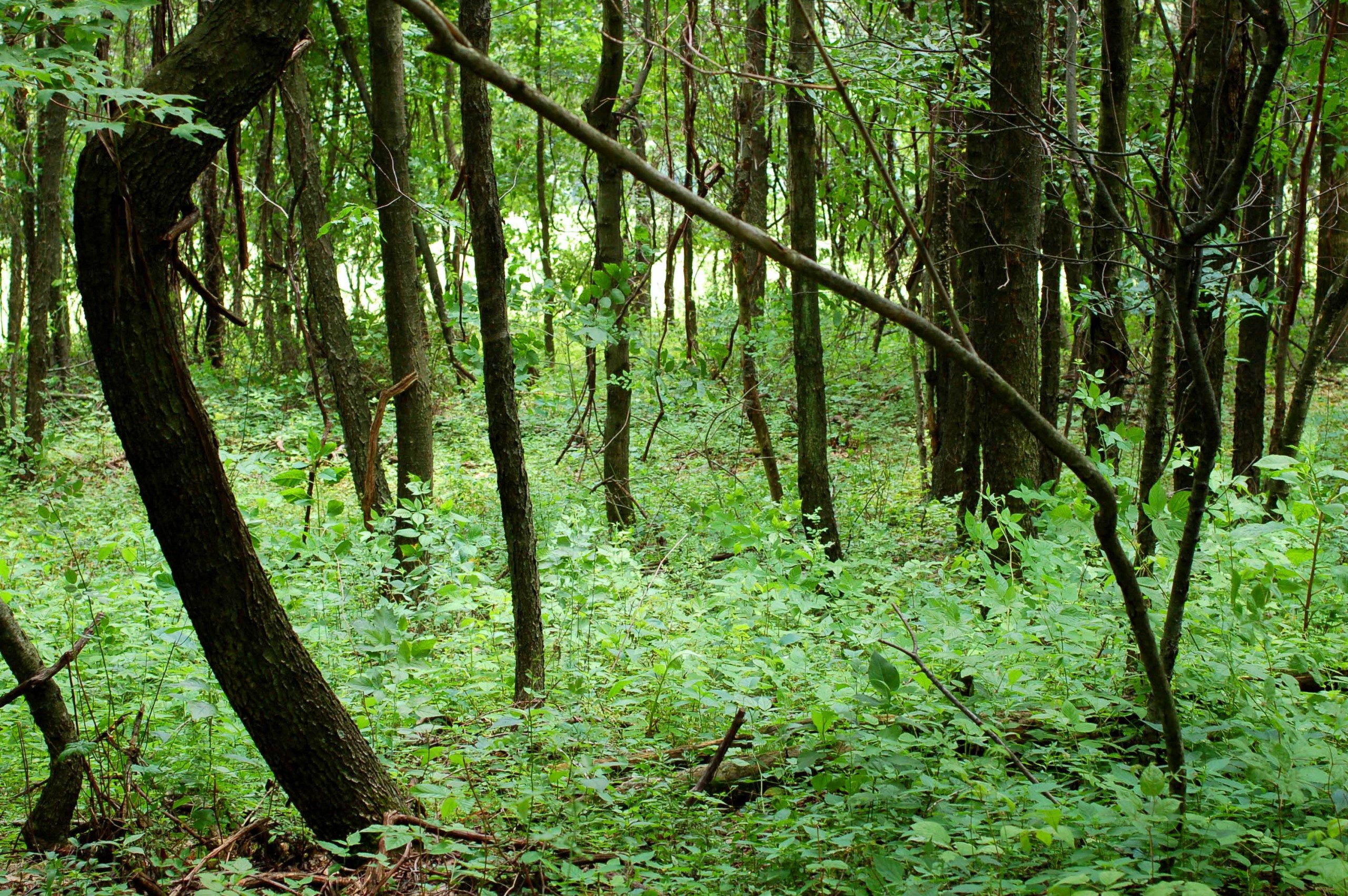
Choosing a Site
The first step is choosing a site to plant. Favorable soil and moisture conditions are most often associated with north or east facing slopes with at least a 75 percent shade canopy. I like an east facing slope so I get the morning sun and by noon the sun doesn’t hit the area directly. Any direction facing N NW around the east side of a hill to the southeast face is a good rule of thumb when choosing an area. I have grown ginseng facing every direction however the conditions were very good. Good soil, trees, shade, etc.
Trees
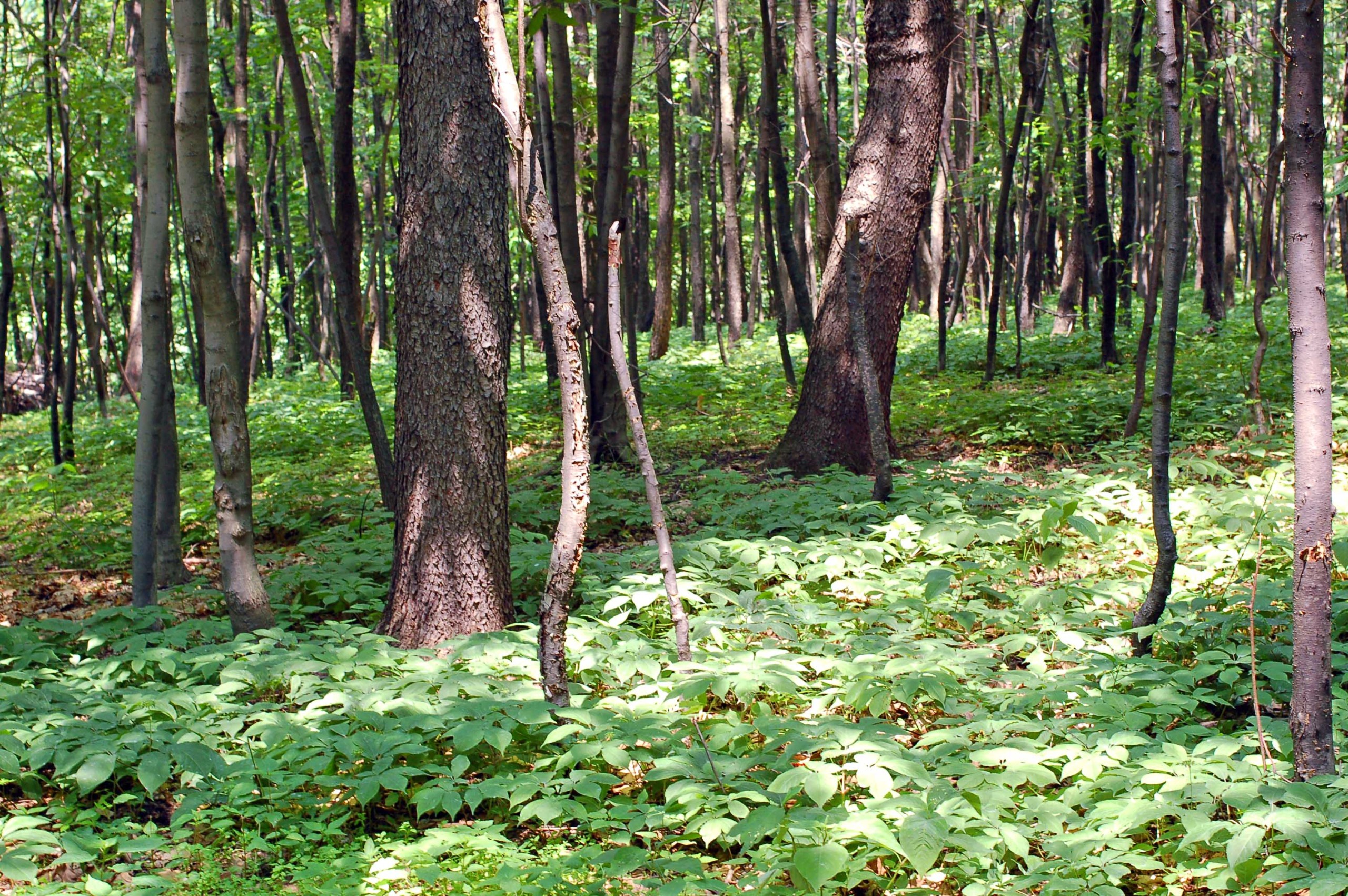 The best shade is provided by what I call small leaved soft hardwoods such as Poplar, Mountain Ash, Cherry, Maple & others. Trees that the leaves will break down quickly and feed the soil within a couple of years and every year after until your ginseng is harvested. I also try and stay away from evergreens and any nut tree, especially oak. The leaves don’t break down as fast and the soil is usually too acidic. Ginseng likes a PH level of around 5.5 to 6.5, I like 6 to 6.5. Remember, you are trying to copy where mother nature grows ginseng.
The best shade is provided by what I call small leaved soft hardwoods such as Poplar, Mountain Ash, Cherry, Maple & others. Trees that the leaves will break down quickly and feed the soil within a couple of years and every year after until your ginseng is harvested. I also try and stay away from evergreens and any nut tree, especially oak. The leaves don’t break down as fast and the soil is usually too acidic. Ginseng likes a PH level of around 5.5 to 6.5, I like 6 to 6.5. Remember, you are trying to copy where mother nature grows ginseng.
Soil Conditions
Ginseng likes to grow in a damp cool, not wet, well-drained loamy soil. Soil that will somewhat compact so that over time you get the stress/growth rings you need on the root. If your soil is to loamy, to loose or sandy type down say 6-8 inches, your root will turn out looking like cultivated ginseng. Carrot like, very smooth sides with no stress rings at all which is not what you or any dealer are looking for. You need at least 3-4 inches of decent topsoil for ginseng to do well. Good soil drainage is essential and swampy or clay soil should be avoided. Swampy is to wet and clay is to hard & not loamy. It won’t hurt to have a little rocky soil to help with the stress. Think of your vegetable garden in the woods. You should do well with that type of soil.
Companion Plants
I like to pick sites where companion plants such as Jack-in-the-Pulpit, Spice Bush, Bloodroot, Solomon’s Seal, Christmas Ferns, Black Cohosh , Blue Cohosh, Golden Seal and others are present. However, if no companion plants are found in the area, it doesn’t mean ginseng won’t grow there. Ginseng just does better when some companion plants area present. Some weeds can be a sign that ginseng will grow in an area as well. White top (Indian snake root), some ivy’s like Wild Ginger, Stinging Nettle, even Grape Vines will show the way to decent soil. Consider them as indicator plants or nuisance plants for decent ginseng growing soil.
, Blue Cohosh, Golden Seal and others are present. However, if no companion plants are found in the area, it doesn’t mean ginseng won’t grow there. Ginseng just does better when some companion plants area present. Some weeds can be a sign that ginseng will grow in an area as well. White top (Indian snake root), some ivy’s like Wild Ginger, Stinging Nettle, even Grape Vines will show the way to decent soil. Consider them as indicator plants or nuisance plants for decent ginseng growing soil.
Site Preparation
For Wild-simulated Ginseng, ginseng seed is planted in the fall when or before the trees lose their leaves. In some locations, clearing of undergrowth will be necessary. If the site is sufficiently shaded, there should not be a great deal of competitive weed growth. I like to see some weeds to know things will grow on the site. Some growers try to disturb the site as little as possible to reduce the spread of fungal disease. I like to clear some of the under growth, sticks, downed trees, weeds and such from the site. Clean the area up a little for easier planting and long term maintenance all in one. I also prep the area early on say spring or even during the prior year making less work come planting time.
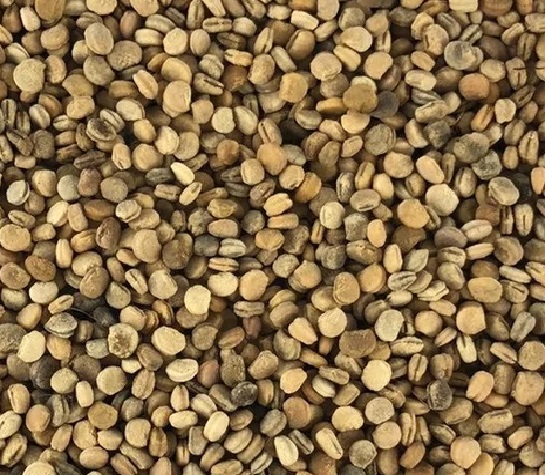
Stratified Ginseng Seed
Ginseng Seed takes about 18 months to grow and produce a plant in the wild, sometimes longer, even years. Normally the berries drop off the plant or are spread around by birds and chipmunks and such. Then the leaves cover them in the fall and they go thru 2 winters minimum before germinating the following spring to produce a plant. I have seen seed lie dormant for 3- 4 years before the conditions were right for it to germinate and grow, both Green & Stratified. I know, that makes no sense. However, I had one section that didn’t come up until the spring of the 4th year after planting.
Some growers recommend that only stratified seed be planted. Others plant both green seed & or stratified seed. Some only plant green seed, my grandad was one of them. I have planted both successfully but only plant stratified seed now. Planting stratified seed means that the seed is only vulnerable to forest varmints and odd weather conditions for a short time period. Say 6 months as opposed to 18 months for green seed and the survival as well as germination rates are much greater for stratified seed.
How to Stratify Seed
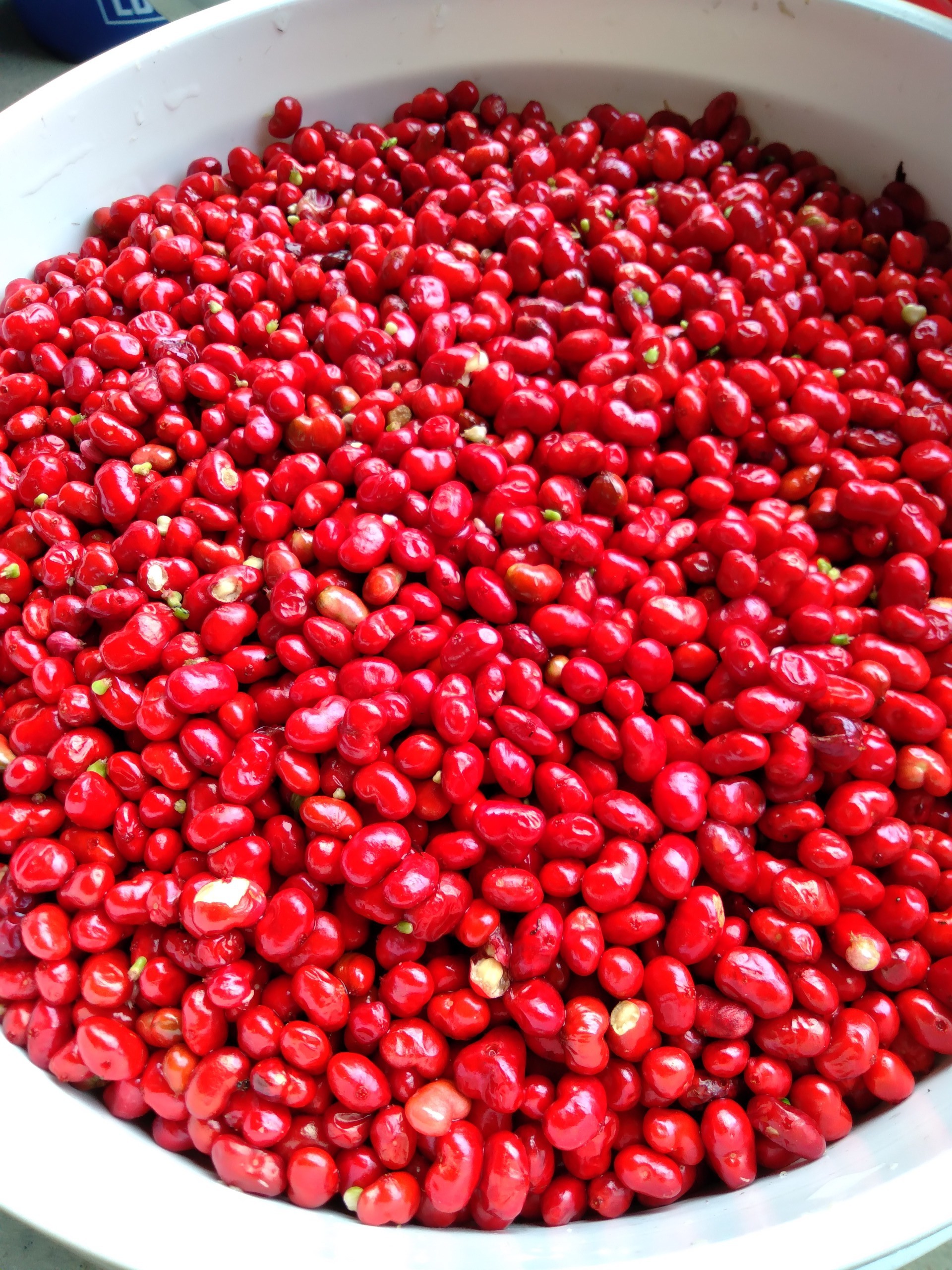 For Stratified Seed you collect ginseng berries after they ripen sometime in late August to early September. Then you de-pulp the berries to get the seed we call Green Seed. Then put the seeds in moist sand over winter until next fall when you take them out of sand, ready for planting season. The process is called stratification. You will need to float the seed after it is out of the sand to discard the bad seed / floaters. Keep the floaters and scatter them on top of the area planted before mulching because some of them will grow.
For Stratified Seed you collect ginseng berries after they ripen sometime in late August to early September. Then you de-pulp the berries to get the seed we call Green Seed. Then put the seeds in moist sand over winter until next fall when you take them out of sand, ready for planting season. The process is called stratification. You will need to float the seed after it is out of the sand to discard the bad seed / floaters. Keep the floaters and scatter them on top of the area planted before mulching because some of them will grow.
Some growers I know just plant the berries as if mother nature put them in the ground.
Stratified ginseng seed should be planted throughout the fall and early winter, September through November, or until the ground freezes. We have planted seed in February thru the 1st week of March after a mid-winter thaw with some success, but no later. We have tried planting in early to late spring, aka late March thru April, 2 or 3 times with no success.
I still recommend planting Ginseng Seed & or Rootlets in the fall just before the leaves come down.
If the Maple leaves are down, your Ginseng Seed & or Rootlets should be in the ground.
Info for Planting Ginseng Seed
The only tools needed when planting wild simulated ginseng are a rake and or a garden hoe. It is a good idea to plant seeds in sectioned off areas that are about 4-5 ft wide. You can make them however long you wish or whatever size the area allows. They can be separated by walkways about 2-3 ft wide. Run them up and down the slope when possible rather than across the area. This will give better air flow and water drainage around the plants.
Rake back the leaf litter into a pile to one side or the other to the desired width. Then rake the soil loose until it’s about ¾ to 1 1/2 inch deep. Some growers even use a small hand cultivator tool to help loosen the soil. Sow/spread the seed on top of the soil thin enough to be around 4-6 seed / sq ft. Turn the rake upside down & re-rake the seed into the loose soil to at least ½ to 3/4 inches deep.
You can then walk on or tamp the soil with something as to lightly pack it down like planting seed in a garden. Then put the leaf litter back on top of the seed & soil you just planted. You can add straw as mulch before the leaves if you need extra mulch. I recommend at least 1 – 2 inches of total mulch, straw and leaves together. If possible, get it done before the leaves come down in the fall giving the area an extra coating of mulch. Also try and plant a day or two before it is scheduled to rain enough to soak but not drench the area.
You can watch a video on planting ginseng seed by clicking on https://www.colwellsginseng.com/ginseng-videos/ .
Planting 1500 sq ft at 4 seed per sq ft will take 1 lb of seed. At this rate of seed a 1/2 acre would take about 15 lb of seed, 1 acre about 30 lb.
I like to say, If the maple leaves are down, your seed should be in the ground.
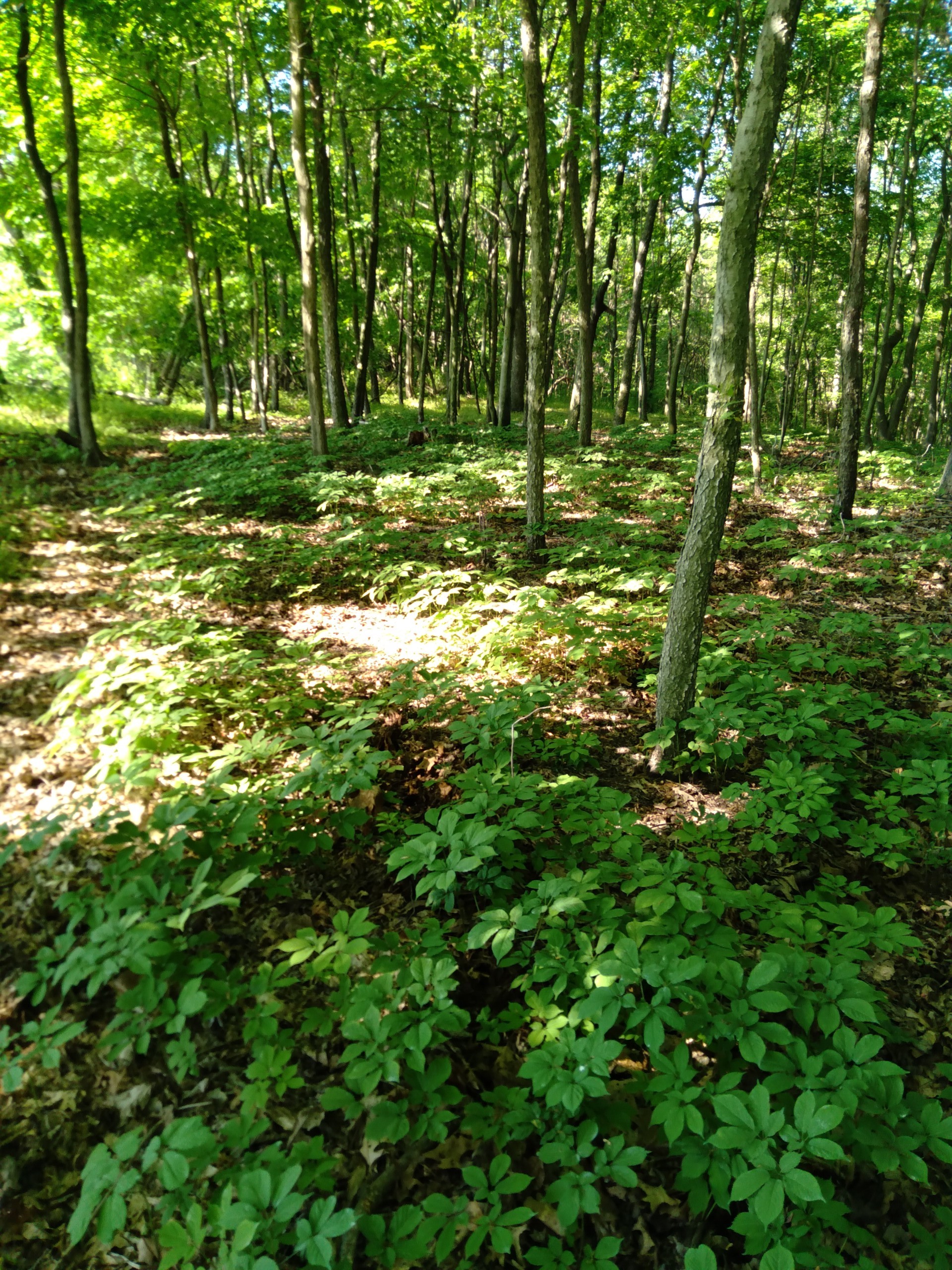
Another method of planting ginseng seed
Rake the leaves back the same as mentioned before. Using the hoe, make narrow furrows about 1 ½ inches deep, 18 inches apart all the way down the length of the planting area. Or make the furrows go across the area about 18 inches apart. Plant seeds by hand 4-6 inches apart in each furrow giving you 6-8 seed / 1.5 sq ft. At this rate it would take about 17.5 lb of seed per ½ acre, and 35 lb per acre.
Cover the seeds with soil after planting, firm the soil around the seeds, then proceed with the mulching, same as the prior method. After a couple of rainstorms no one will be able to detect that any planting took place regardless of which method you use. The site should look almost completely natural.
Plant growth & maintenance
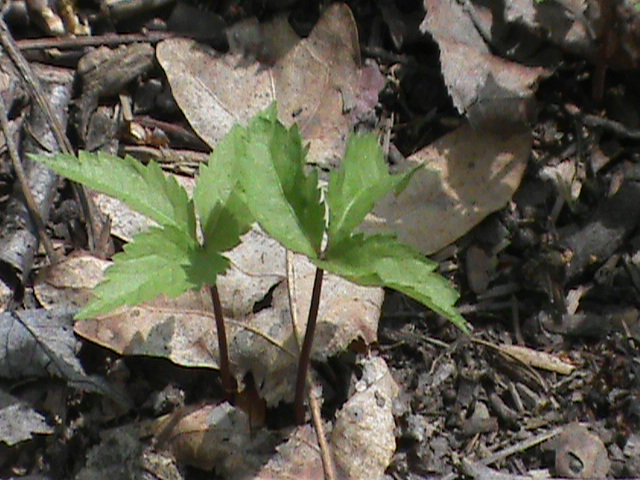 The stratified seed should germinate and start to grow next spring. The plants will have three small leaves on a stem about an inch or two tall. Some of the seeds will not germinate, and some will be eaten by rodents and other pests. Over the next several years, the plant population in each area will be reduced for various reasons. Your final stand of ginseng will most likely be a thin healthy population of wild-simulated/ wild ginseng plants. If you manage to harvest 1 to 2 plants per sq ft you will have a very nice yield.
The stratified seed should germinate and start to grow next spring. The plants will have three small leaves on a stem about an inch or two tall. Some of the seeds will not germinate, and some will be eaten by rodents and other pests. Over the next several years, the plant population in each area will be reduced for various reasons. Your final stand of ginseng will most likely be a thin healthy population of wild-simulated/ wild ginseng plants. If you manage to harvest 1 to 2 plants per sq ft you will have a very nice yield.
When you plant using a wild-simulated ginseng method, little or no work will be required until harvest time 8-10 years later. The ginseng plants are left to the mercy of mother nature if you wish. Weeds and trees will compete with the plants for water and nutrients. The plants will struggle to grow in barely cultivated soil. You can weed your ginseng if you wish once or twice over that time period. Or leave them to their own device.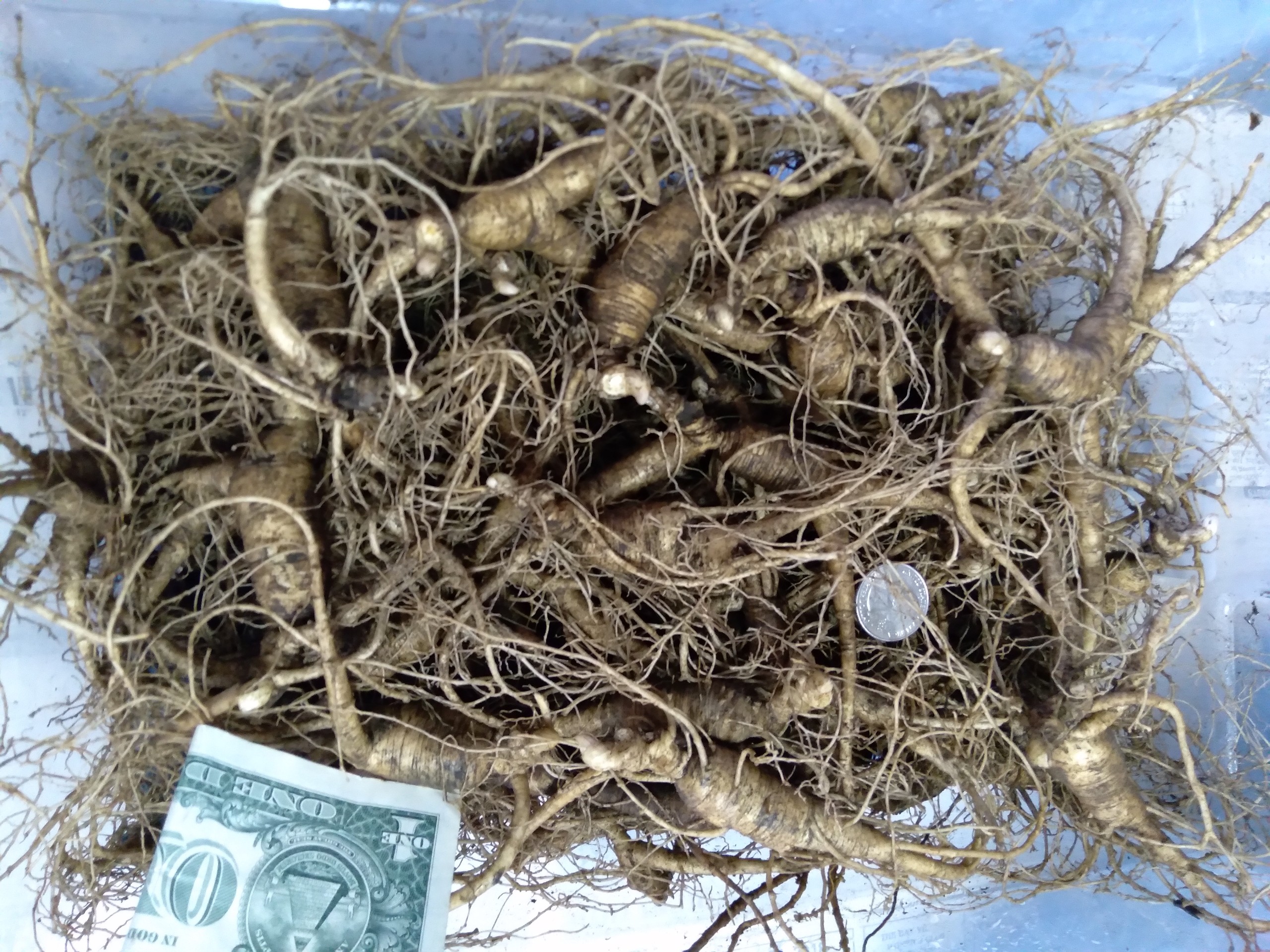
These stressful conditions should result in the wild appearance of the roots that are eventually harvested.
Exactly what you’re looking to achieve.
Planting Seed Thick
Some growers try and push the limit when planting ginseng seed. They will plant as much as 50 to 80 lb. of seed per acre. While this can result in a larger harvest, it will most definitely result in trouble with disease.
Alternaria leaf blight,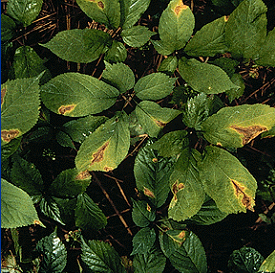
Phytophthora stem and leaf blight, 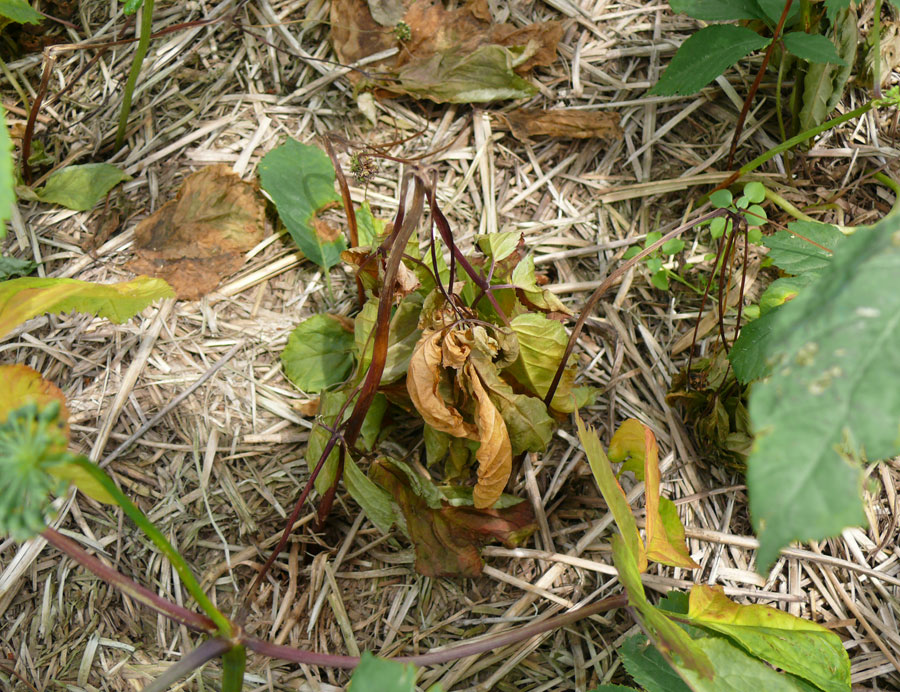
with a burgundy color on the stem which are signs of possible root rot,
Phytophthora crown and root rot,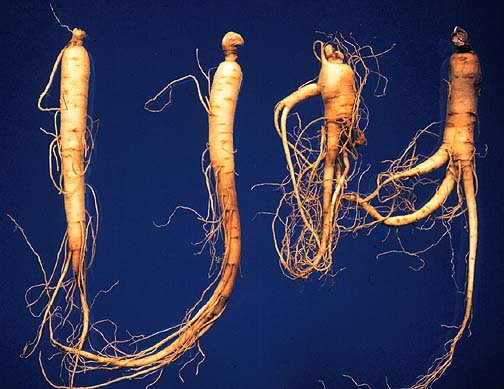
There are still others such as Rusty Root, Botrytis Blight, which I think causes damping off, Rhizoctonia, which attacks the neck, aka rhizome, where the bud for the next year growth is formed.
Fusarium is another and I am sure there are some diseases I am not aware of.
If you decide to plant that thick, you will have to treat for disease. Preventive maintenance is the best way to combat the issue. There are many sites on the web that have info on how to recognize and what to do for the fungus you will encounter. You will have to do your homework to stay ahead of it. You will have losses to this problem and there is a lot more work involved in growing ginseng that thick.
Preventive maintenance. Get it before it starts!
Ginseng Rootlets
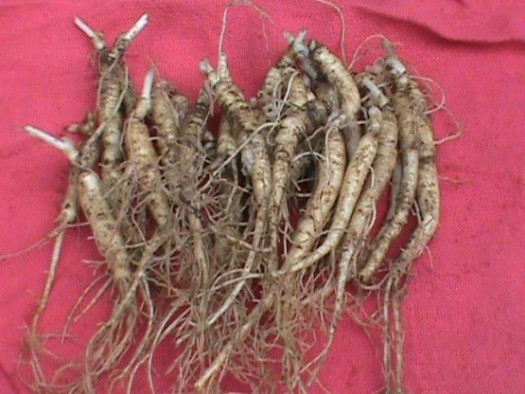 Many people prefer to plant ginseng rootlets which are 2 – 5 year old whole roots. This not only enables them to get a head start on harvesting usable root ahead of planting seed alone, it gives them an idea of what the different ages of ginseng plants would look like in coming years.
Many people prefer to plant ginseng rootlets which are 2 – 5 year old whole roots. This not only enables them to get a head start on harvesting usable root ahead of planting seed alone, it gives them an idea of what the different ages of ginseng plants would look like in coming years.
Some growers think it is best to transplant the rootlets in spring and fall. In the spring ,usually March and April, just before the bud starts to grow a new plant depending on where you live. I do not.
I prefer & recommend planting in the fall after the berries have ripened and the plant starts to turn color and die off for the winter. This is when the root starts to go dormant for the winter. That time is September and October in most regions. Like seed, you can plant rootlets up until the ground freezes if need be. I always say, if the maple leaves are down, your Ginseng Seed and or Rootlets should be in the ground.
You should handle rootlets carefully, taking care not to damage the rootlet during transplanting. Damaged rootlets can and will rot sometimes or not come up for a couple of years if the bud is damaged. Plant rootlets in the fall, leave them alone then see what comes up in the spring. Like seed some will grow and some will not. However I don’t give up on rootlets unless I know that they’ve rotted. Sometimes the bud won’t survive transplanting but the root will produce a new bud in subsequent years and produce a plant again. Hopefully they will grow and be far enough apart to keep disease away.
I will always recommend planting rootlets in the fall to early winter.
Info for Planting Ginseng Rootlets
Rake the leaves back the same as before. Using the hoe, make narrow furrows about 3-4 inches deep, 18 inches apart all the way down the length of the area your planting. Or make the furrows go across the area about 18 inches apart. You then put each rootlet in the furrow with the bud up by laying the rootlet in the bottom along the side of the furrow. Make sure the small fiber root is in the bottom of the furrow.
Now you can cover the rootlets with the soil and slightly pack with your hand so there is about 1-1 ½ inches of soil on top of the bud. You should keep your rootlets about 1-2 feet apart to help keep disease away. With your rootlets covered with soil you can now put the mulch/leaf litter back on top of your rootlets and you’re done.
To watch a video on planting ginseng rootlets click on https://www.colwellsginseng.com/ginseng-videos/ .
Remember, if the maple leaves are down, your rootlets and or seed should be in the ground.
Tillage Note
If you want to till the soil with say a mechanized tilling machine, or even a set of food plot discs, it shouldn’t hurt the quality of your root. After raking the leaves back, you only need to till the top 4 inches to achieve what you need. Then you would plant your seed & or rootlets as mentioned earlier. What this will do is give your seed & or rootlets an easier time of getting started in your growing area. It will also be a little easier to plant.
Within a couple of years mother nature will help the soil firm back up close to prior conditions. In that time your crop should be well on its way to successful growth and in coming years get the stress it needs to gain the quality you are looking for provided you leave it grow long enough. The older the root, the better, 8 – 10 yrs of growth should do it.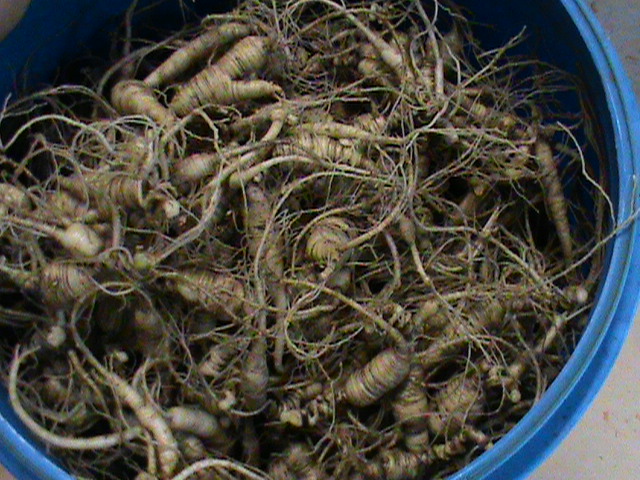
Final Note
Remember, there is always something or some kind of pest to look for and worry about when growing ginseng.
Growing Ginseng is not for the person that thinks it’s a quick buck, it’s not. Like any other project, hobby, adventure, or business; it’s work, planning, heartache, and yes satisfaction.
It takes years to be successful growing ginseng. My family has 80+ years of growing experience with all sorts of trials and tribulations as well as failures and successes. From good ground to bad ground, money lost and money made, dealing with varmints and pests of all kind.
I can remember picking ginseng berries for my grandad at 5 or 6 years old, a lifetime ago. My mother and I planted some of our own when I was in grade school. I then started my own operation as a young adult. Later on in life I took over for my 86 year old grandad to continue the tradition. My son, now in his 40’s, went thru the same experiences and is now growing his own. From my grandfather to me and now my son, we would all do it all over again & again & again. As my son would say, it is a part of us, it helps define who we are.
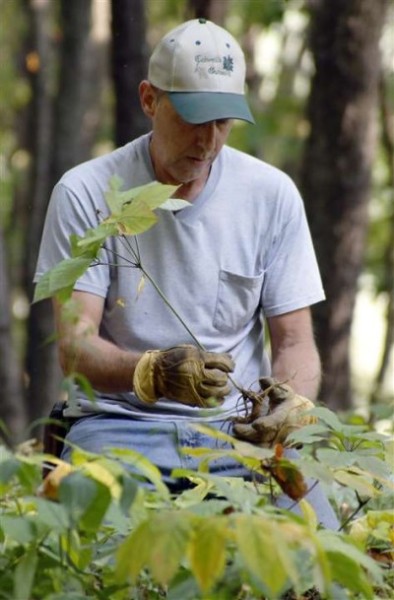 I sincerely hope reading this has helped anyone interested in growing wild simulated ginseng with some of the questions they may have had. As always you can contact us with any other questions you might have.
I sincerely hope reading this has helped anyone interested in growing wild simulated ginseng with some of the questions they may have had. As always you can contact us with any other questions you might have.
Thanks for your interest,
Denny
MESSAGE US YOUR INQUIRIES QUESTIONS OR FEEDBACK
Colwell’s Ginseng
Denny Colwell, Owner
New Bethlehem, PA. 16242
Phone: (814) 275-4710
[email protected]
.
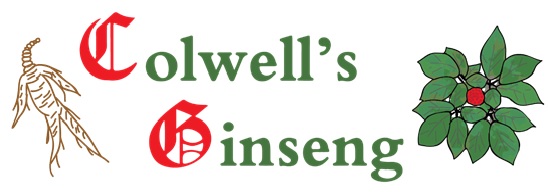
Western Pennsylvania Appalachian Mountain Wild Simulated Ginseng Grower

